Duccio di Buoninsegna stands as one of the most influential and transformative artists of late medieval Italy. Active primarily in Siena from the late 13th to the early 14th century, he is widely regarded as the father of the Sienese School of painting. His work masterfully blended the solemn grandeur of Byzantine tradition with the nascent stirrings of Gothic naturalism and human emotion, creating a style of profound lyrical beauty and narrative sophistication. Duccio's art not only defined Sienese painting for generations but also played a crucial role in the broader transition towards the Renaissance.
The Sienese Context: A City of Art and Devotion
To understand Duccio, one must first appreciate the unique cultural and artistic environment of Siena. During the late Middle Ages, Siena was a prosperous and fiercely independent city-republic, a significant rival to Florence in both political and artistic spheres. Sienese art, while sharing some common Italian roots, developed distinct characteristics. It often emphasized decorative elegance, rich color, sinuous lines, and a more conservative adherence to Byzantine forms, albeit infused with a particular Sienese grace and refinement.
The city's deep Marian devotion was a powerful force shaping its artistic output. The Virgin Mary was the patron saint of Siena, and her image was central to civic and religious life. This devotion fueled commissions for numerous altarpieces and frescoes depicting the Madonna and Child, providing fertile ground for artists like Duccio to innovate within established iconographic traditions. The Sienese valued beauty and craftsmanship, and their artists were held in high regard, contributing to a vibrant artistic culture.
Early Life and Artistic Formation: Shadows and Beginnings
Details about Duccio di Buoninsegna's early life and training are scarce, a common challenge when studying artists of this period. He was likely born around 1255-1260 in Siena or its surrounding territory. The name "Buoninsegna" refers to his father. The first documented mention of him as a painter dates to 1278, when he was paid for decorating twelve painted wooden chests intended to hold Sienese state documents. This early commission suggests he was already an established craftsman.
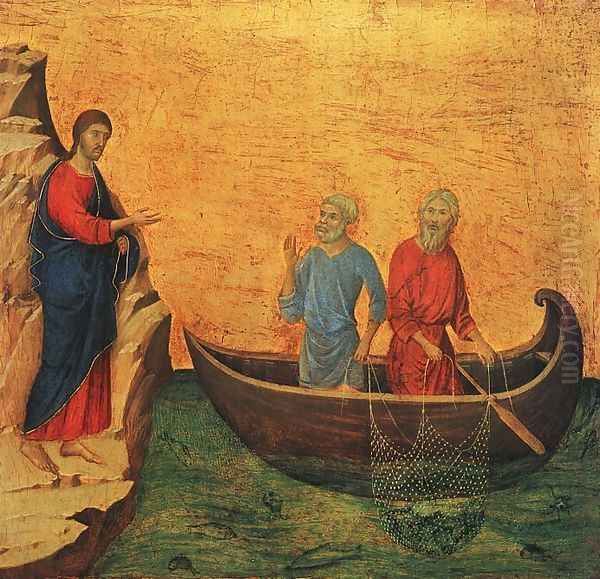
His artistic formation would have involved an apprenticeship in a Sienese workshop, where he would have learned the techniques of panel painting, including the preparation of wooden panels with gesso, the application of tempera paint (pigments mixed with egg yolk), and the intricate art of gilding with gold leaf. The dominant artistic influence in Siena at this time was still heavily Byzantine, characterized by stylized figures, flat perspectives, and symbolic representations. Artists like Guido da Siena, active a generation earlier, represent this Sienese-Byzantine tradition.
However, new artistic currents were beginning to emerge. In Florence, Cimabue (Cenni di Pepo) was already pushing the boundaries of Byzantine art, introducing greater naturalism, volume, and emotional depth into his figures. It is highly probable that Duccio was aware of Cimabue's work, and perhaps even traveled to Florence or encountered Cimabue's paintings through other channels. The interaction between Sienese and Florentine artists, though often marked by rivalry, also fostered artistic exchange and development.
The Rucellai Madonna: A Florentine Triumph and a Stylistic Leap
One of Duccio's earliest and most significant surviving works is the "Madonna and Child Enthroned with Six Angels," famously known as the Rucellai Madonna. This monumental panel was commissioned on April 15, 1285, by the Compagnia dei Laudesi di Santa Maria Novella, a lay confraternity in Florence, for their chapel in the Dominican church of Santa Maria Novella. The fact that a Sienese artist received such a prestigious commission in Florence, a city with its own formidable artistic talents like Cimabue, speaks volumes about Duccio's burgeoning reputation.
The Rucellai Madonna, now housed in the Uffizi Gallery in Florence, is a masterpiece of early Italian painting. While it retains elements of Byzantine iconography, such as the golden background and the hierarchical scale of the figures, Duccio introduces a remarkable softness, grace, and humanity. The Virgin's face is tender and subtly modeled, her drapery flows with an unprecedented fluidity and elegance, creating delicate, calligraphic patterns. The Christ Child, though still depicted with a mature solemnity typical of the period, has a more naturalistic posture and interacts gently with his mother.
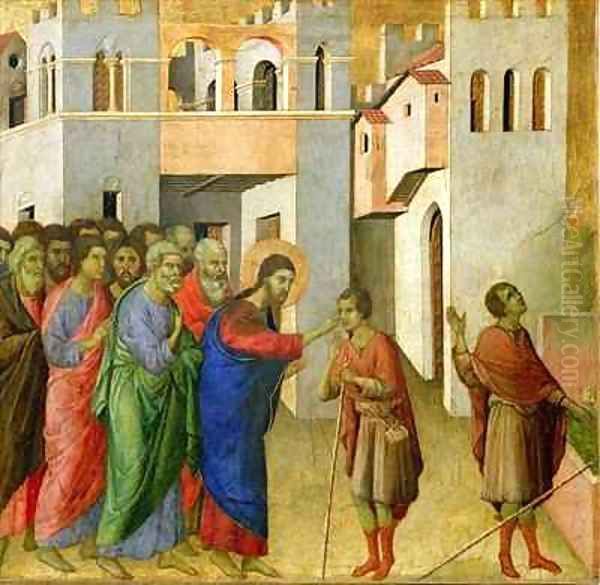
The six angels flanking the throne are rendered with individual charm, their forms subtly varied. Duccio's use of color is rich and harmonious, and the intricate gold tooling on the halos and borders enhances the panel's preciousness. Compared to earlier works by artists like Coppo di Marcovaldo or even some of Cimabue's more austere Madonnas, Duccio's Rucellai Madonna exhibits a new lyrical quality and a refined sensibility that would become hallmarks of the Sienese style. For many years, this work was actually attributed to Cimabue, a testament to the stylistic innovations it presented, even to later art historians like Giorgio Vasari.
The Maestà: Siena's Crowning Glory
The undisputed magnum opus of Duccio's career, and one of the most important works in the history of Western art, is the Maestà (Majesty). This colossal double-sided altarpiece was commissioned on October 9, 1308, for the high altar of Siena Cathedral (Duomo di Siena). The contract stipulated that Duccio paint it with his own hands and that he work exclusively on it until completion. The Sienese were investing heavily in this work, which was intended to be a magnificent tribute to the Virgin Mary, the city's protector, especially after Sienese victories attributed to her intercession, such as the Battle of Montaperti in 1260.
Completed in June 1311, the Maestà was carried in a triumphant procession from Duccio's workshop to the Cathedral, an event described by a contemporary chronicler as a moment of great civic pride and religious fervor, with shops closed and the entire populace participating. This underscores the immense cultural and spiritual significance of the altarpiece.
The front of the Maestà depicted the Virgin and Child enthroned in majesty, surrounded by a celestial court of angels and saints, including Siena's four patron saints: Ansanus, Sabinus, Crescentius, and Victor. The Virgin is depicted with serene dignity and maternal tenderness, her blue mantle rendered with exquisite folds. The Christ Child offers a blessing. The figures, while maintaining a sense of divine solemnity, possess a new softness and individual characterization. The sheer scale and the richness of the gold and vibrant colors would have created a dazzling spectacle in the candlelit interior of the cathedral.
The reverse side of the Maestà was even more innovative, featuring a narrative cycle of twenty-six panels depicting scenes from the Passion of Christ. This extensive narrative sequence, meant to be viewed by the clergy in the choir, showcased Duccio's remarkable storytelling abilities. He arranged complex scenes with clarity, imbuing the figures with a range of human emotions – grief, betrayal, suffering, and compassion. While still employing Byzantine conventions for some settings, Duccio introduced a greater sense of spatial depth and more naturalistic interactions between figures than had been seen before in Sienese art.
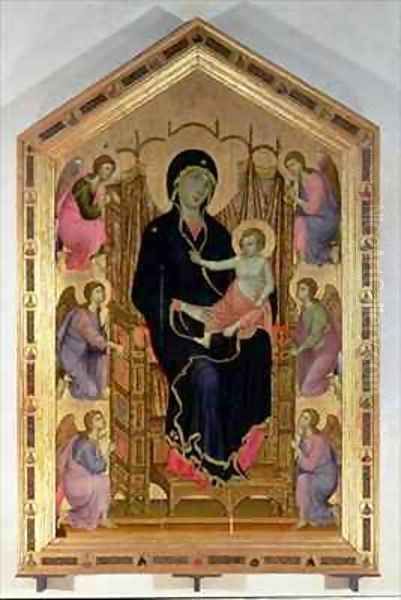
Above and below these main sections, on both front and back, were smaller predella panels and pinnacles depicting scenes from the early life of Christ, the life of the Virgin, and Christ's post-Resurrection appearances. Unfortunately, the Maestà was dismantled in 1771, and its numerous panels were dispersed. While the main central panel and many others are now housed in the Museo dell'Opera del Duomo in Siena, other pieces found their way into collections worldwide, including the National Gallery in London (e.g., The Annunciation, Jesus Opens the Eyes of a Man Born Blind), the National Gallery of Art in Washington D.C. (e.g., The Calling of the Apostles Peter and Andrew, The Nativity with the Prophets Isaiah and Ezekiel), and the Frick Collection in New York (e.g., The Temptation of Christ on the Mountain).
Artistic Style and Innovations: A Synthesis of Traditions
Duccio's artistic style is a sophisticated synthesis. He absorbed the formal elegance and iconographic richness of Byzantine art, with its emphasis on linearity, gold backgrounds, and spiritual intensity. However, he infused this tradition with elements derived from French Gothic art, particularly its graceful, flowing lines, refined sensibility, and interest in narrative detail. This Gothic influence likely reached Siena through illuminated manuscripts, ivories, and stained glass.
A key innovation in Duccio's work is the humanization of sacred figures. While his Madonnas and saints retain their divine aura, they also exhibit a newfound tenderness, gentleness, and psychological subtlety. His figures are less rigid and more animated than those of his predecessors. Draperies are no longer stiff, schematic patterns but fall in soft, elegant folds that suggest the form of the body beneath.
In his narrative scenes, particularly on the back of the Maestà, Duccio demonstrated a remarkable ability to convey complex stories with clarity and emotional impact. He experimented with perspective and architectural settings to create a more believable sense of space, though not yet the fully rationalized perspective that would be developed by later Renaissance artists like Filippo Brunelleschi and Leon Battista Alberti. His compositions are carefully balanced, and his use of color is both rich and harmonious, often employing deep blues, vibrant reds, and delicate pinks, all set against the luminous gold.
Duccio's attention to detail is also noteworthy. He often included small, anecdotal elements that add to the realism and charm of his scenes. His work is characterized by a profound lyricism, a poetic quality that distinguishes Sienese painting from the more monumental and dramatic style developing in Florence under Giotto di Bondone.
Technique and Materials: The Craft of a Master
Duccio was a master of the tempera and gold leaf techniques prevalent in his time. Panel paintings like the Rucellai Madonna and the Maestà were complex undertakings. The process began with the careful selection and preparation of wooden panels, typically poplar, which were smoothed and covered with layers of gesso (a mixture of animal glue and gypsum or chalk) to create a brilliant white, absorbent surface.
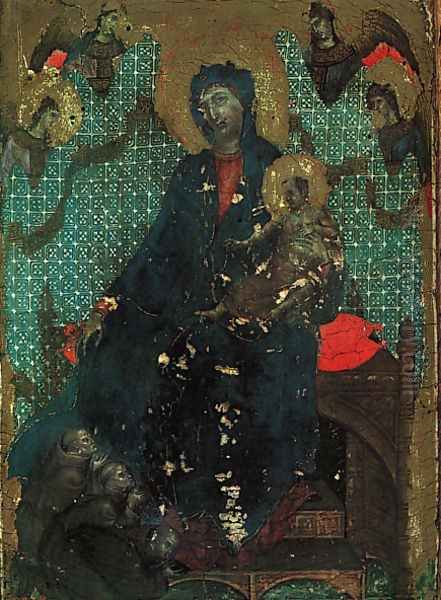
The design would then be incised or drawn onto the gesso. Areas to be gilded were prepared with a layer of bole (a reddish clay mixture) which provided a warm undertone for the gold leaf and allowed it to be burnished to a high sheen. Thin sheets of gold leaf were meticulously applied. Intricate patterns could then be tooled, punched, or incised into the gilded surface, creating rich textures and shimmering effects, especially visible in halos and drapery borders.
The painting itself was done in tempera, a fast-drying medium that required careful application in small, hatched strokes to build up forms and model figures. Duccio was renowned for his refined brushwork and his ability to create subtle gradations of color and tone. The pigments he used were derived from minerals, earths, and other natural sources, ground by hand and mixed with egg yolk and water. The brilliance of these colors, combined with the splendor of the gold, contributed to the precious, jewel-like quality of his work.
Duccio and His Contemporaries: A Tale of Two Cities
The late 13th and early 14th centuries were a period of extraordinary artistic ferment in Tuscany. Duccio's main contemporary and, in many ways, his artistic counterpart, was the Florentine painter Giotto di Bondone (c. 1267-1337). While both artists were pioneers who moved beyond the strictures of Byzantine art, they took different paths.
Giotto, often hailed as the true precursor of the Renaissance, focused on creating figures with a strong sense of volume, weight, and psychological presence. His work, exemplified by the frescoes in the Scrovegni Chapel in Padua, emphasizes human drama, clear narratives, and a more rational approach to space. Giotto's figures are monumental and sculptural.
Duccio, on the other hand, while also imbuing his figures with greater naturalism and emotion, retained a stronger connection to the decorative elegance and linear grace of the Byzantine and Gothic traditions. His art is more lyrical, more concerned with refined beauty, intricate patterns, and harmonious color. While Giotto's figures inhabit a more tangible, earthly space, Duccio's often exist in a more ethereal, spiritual realm, albeit one touched by human tenderness.
It's not a matter of one being "better" than the other; rather, they represent two distinct but equally valid artistic visions that profoundly shaped the course of Italian painting. Duccio's influence was paramount in Siena, while Giotto's dominated Florentine art. Other important Italian painters of this era include the Roman artist Pietro Cavallini, whose work also showed a move towards greater naturalism and classical monumentality, and the aforementioned Cimabue, who was a crucial transitional figure.
The Sienese School and Duccio's Legacy: A Flourishing Tradition
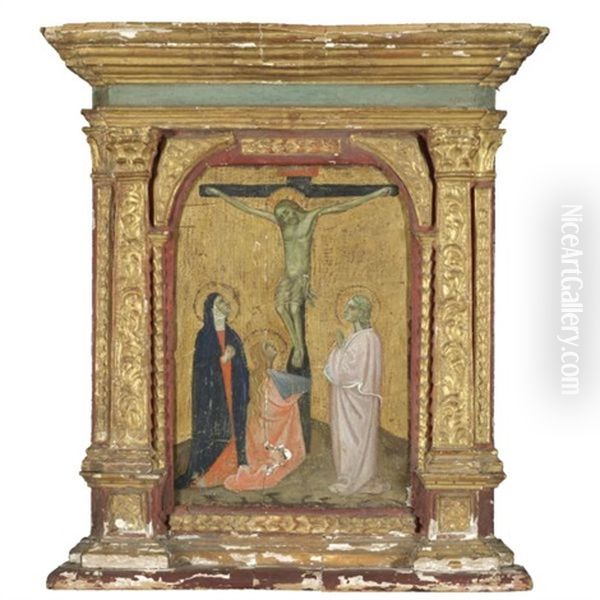
Duccio is rightly considered the founder of the Sienese School of painting, which flourished throughout the 14th century. His innovations and distinctive style set the tone for subsequent generations of Sienese artists. His workshop was likely a busy one, training numerous assistants and followers.
Among his most important followers were Simone Martini (c. 1284-1344) and the brothers Pietro Lorenzetti (c. 1280-1348) and Ambrogio Lorenzetti (fl. 1319-1348). Simone Martini further developed Duccio's elegance and linear grace, infusing it with a courtly sophistication derived from French Gothic art. His Maestà fresco in Siena's Palazzo Pubblico (1315) is a direct response to Duccio's altarpiece, and his Annunciation (1333, Uffizi, with Lippo Memmi) is a quintessential example of Sienese Gothic refinement.
The Lorenzetti brothers, while deeply influenced by Duccio, also absorbed some of Giotto's interest in spatial construction and dramatic narrative. Pietro Lorenzetti's work often displays a powerful emotional intensity, while Ambrogio Lorenzetti is famed for his complex allegorical frescoes of Good and Bad Government in the Palazzo Pubblico, which demonstrate a keen observation of contemporary Sienese life and an ambitious attempt at panoramic perspective.
Other artists associated with Duccio or his immediate circle include his nephew Segna di Buoninsegna, who continued Duccio's style with a somewhat more conservative approach, and Ugolino di Nerio, whose works closely emulate Duccio's compositions and figure types. The "Master of Badia a Isola" and the "Master of Città di Castello" are names given to anonymous artists whose styles are very close to Duccio's, possibly representing early phases of his work or close workshop collaborators. The influence of Duccio's Maestà was so profound that it became a model for Sienese altarpieces for decades.
Later Life, Controversies, and Rediscovery
Despite his artistic achievements, Duccio's life was not without its troubles. Archival documents reveal a man who was frequently in debt and faced various fines and legal issues. He was fined for unpaid debts, for refusing to swear fealty to the Capitano del Popolo, and even, on one occasion, for an unspecified offense related to sorcery, though the nature of this charge is unclear and may have been minor. In 1302, he was fined for refusing to serve in the Sienese militia in Maremma. These records paint a picture of a somewhat rebellious or perhaps financially imprudent individual.

He is last documented in 1319, and it is believed he died around this time, possibly in Siena. His wife was Taviana, and they had at least seven children. Despite his fame, his family apparently renounced his inheritance after his death, likely due to his outstanding debts.
For centuries, Duccio's reputation was somewhat overshadowed, particularly outside Siena, by the towering figure of Giotto, whose innovations were seen as more directly leading to the High Renaissance. Giorgio Vasari, in his influential "Lives of the Artists" (1550, revised 1568), gave Duccio relatively brief and somewhat dismissive treatment, even misattributing the Rucellai Madonna to Cimabue.
However, from the late 19th century onwards, art historians began to re-evaluate Duccio's work and his crucial role in the development of Italian painting. Increased scholarly research, the rediscovery and reattribution of his works, and a greater appreciation for the unique qualities of Sienese art led to a resurgence of interest in Duccio. Today, he is universally recognized as one of the greatest painters of the medieval period, a master whose work combines spiritual depth with exquisite beauty.
Enduring Influence and Conclusion: A Lyrical Voice in Art History
Duccio di Buoninsegna's impact on the history of art is undeniable. He transformed Sienese painting, moving it beyond its Byzantine antecedents to create a style that was both deeply spiritual and exquisitely human. His emphasis on graceful lines, rich color, emotional tenderness, and narrative clarity established the distinctive character of the Sienese School, which would remain a vital artistic force for over a century, producing masters like Sassetta (Stefano di Giovanni) and Giovanni di Paolo in the 15th century, who continued to echo Duccio's lyrical sensibility.
While the Florentine path blazed by Giotto, with its focus on monumental form and rational space, ultimately became the dominant trajectory leading to the High Renaissance masters like Leonardo da Vinci, Michelangelo, and Raphael, Duccio's contribution represents a crucial and beautiful alternative. He demonstrated that innovation could also come through refinement, through a poetic fusion of old and new, and through an unwavering commitment to beauty and emotional expression.
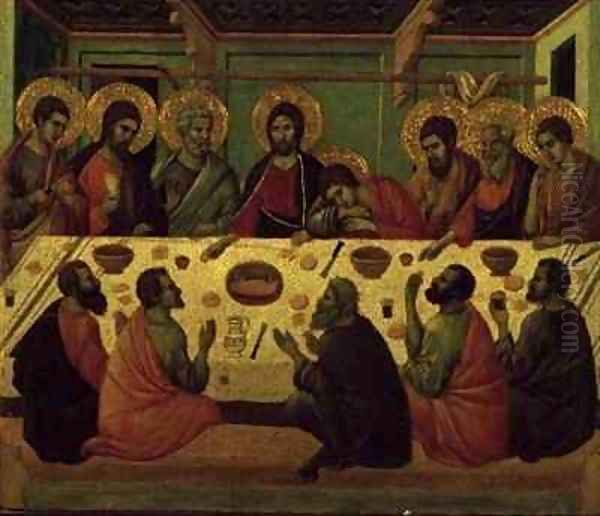
His masterpieces, particularly the Maestà, stand as testaments to his genius and to the vibrant artistic culture of medieval Siena. Duccio di Buoninsegna remains a pivotal figure, a lyrical voice whose art continues to captivate and inspire, bridging the spiritual world of the Middle Ages with the emerging humanism of the Renaissance. His ability to convey profound religious feeling with such delicate artistry ensures his enduring place among the great masters of Western painting.